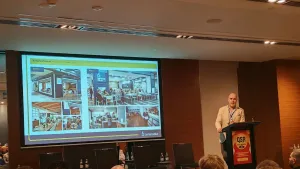
How e-Commerce inspired TabSquare's personalised digital menus
The company explains why digital menus help tap into a consumer’s ‘indecision of choice’.
(Editor's Note: The article was originally written by TabSquare. Click here to see the original article.)
TabSquare’s digital menu solution meets the high expectations of tech-savvy, next-generation customers. It also ticks the boxes for key customer experience criteria, including; personalisation, engagement, and delight. But where exactly did the inspiration for the development of this cutting-edge technology come from?
It was born from close scrutiny of e-commerce giants like Amazon. This online retailer stands out from its competitors in a number of ways - one of which is how it offers each customer a unique landing page. These landing pages are personalised for each user based on previous engagements, offering the user a unique experience.
Most of us have experienced and enjoyed these intuitive interactions first-hand. Some of us may not have even noticed that we are continually seeing cross-sell and up-sell promotions due to the smooth user experience.
The subtle nature of this type of selling makes it almost impossible to complete a transaction online without an offer to buy similar products, add to the product purchase, sign up to an email newsletter, or similar personalised interactions. Just think about how often additional products are suggested when you’re shopping online. Or how similar music and movies are highlighted when you’re on Spotify or Netflix.
Amazon’s (and similar online retailer’s) innovative e-commerce interface uses artificial intelligence (AI) in the background to recognise the products in the customer’s order basket and automatically recommend related products based on consumer purchasing patterns. AI is the driving force that identifies browsing habits and creates personalised recommendations based on these.
Personalised dining for every guest
In the same way, TabSquare’s AI engine - nicknamed Aiden - helps drive restaurants’ profitability by creating seamless operations, saving on labour costs, boosting average bill value by up to 15% and speeding up table turns. Aiden does this by analysing over 60 factors to understand every diner’s taste preference. It then customises their dining experience to make it more personal, convenient and satisfying.
Modern consumers are money-conscious and know how to shop around for the best deal. AI adds value by helping customers find exactly what they need, ensure they feel good about it, and most importantly, keep them coming back for more.
The success of this is clear. According to Forrester Research analyst Sucharita Mulpuru-Kodali, product recommendations are responsible for 10 to 30 percent of e-commerce site revenue. Some years ago, Amazon reported that 35 percent of its revenues were a direct result of its cross-sells and up-sells, this number will continue to increase in the coming years.
TabSquare uses AI technology in the same way; seamlessly integrating it into the digital ordering solutions that drive its customers’ food and beverage menus. Inspired by the e-commerce personalisation model, SmartKiosk, SmartTab, and SmartWeb combine data from previous customer visits with deep learning algorithms to identify customers and analyse their dining patterns and preferences. This solution offers customers individualised menu item options in a way that is far faster and richer than traditional paper menus could ever do.
Digital menus bypass ‘indecision of choice’
An online e-commerce retailer might up-sell by suggesting a premium plan on a subscription service, shoes to go with a dress in a customers’ basket or batteries needed for a toy. A food and beverage digital menu operates in a similar way.
When a customer selects a main meal, they are presented with drink or additional side dish options to match their food preferences. If they are a returning customer, they can see their previous orders and select something they enjoyed on their last visit, or use the suggested items section to find something new that is catered to their taste palette.
Digital menus help tap into a consumer’s ‘indecision of choice’ and guide them towards a purchase decision in the same way that e-commerce does. While traditional large menus can cater to a wider demographic with additional food preferences, too many options can lead to indecisiveness. In the worst-case, the customer may be overwhelmed and choose to buy nothing.
Using digital menus and AI to present a refined menu with personalised suggestions solves this problem. It ticks all the boxes in creating optimal customer experience and delivering increased profitability.
(Download TabSquare's white paper to find out how to move your venue into the digital age.)
























